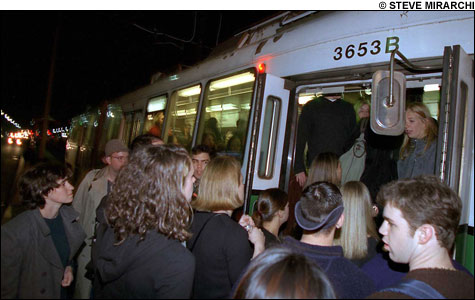
NOT EASY BEING ON THE GREEN: The line may be notoriously slow and crowded, but there have been some improvements of late. |
When the T works, we usually don’t notice. But when it doesn’t, our reaction is swift and severe. Blood pressures rise; heads are buried in hands and hair is pulled out; anger and despair run rampant. And for those who seek a scapegoat, there’s an obvious choice: the guy who runs the damn thing.For those who haven’t experienced this rail rage firsthand, here’s a case study. A few weeks ago, walking up the ramp to the Swampscott commuter-rail stop, I passed a woman walking down the ramp, toward the street; she was muttering to herself and seemed to be on the verge of tears. Up at the station, the LED message board suggested an explanation: the 7:25 and 7:55 am trains were both running about an hour late, and the former wasn’t taking any passengers. (Of course, this information would have been more useful if it wasn’t already pushing 9:30.)
The train finally came, everybody found seats, and a conductor entered my car. A woman sitting near me suggested that — since she’d been waiting an obscenely long time, and hadn’t been allowed to board the last train that showed up — she shouldn’t have to pay. The conductor replied, testily, that this passenger could fill out a refund request, but that she (the conductor) would lose her job if she didn’t collect every fare. After the conductor moved on, an impromptu gripe-fest ensued: this happens all the time! On a good day, it’s quicker to drive into Boston! Fares and passes cost too much! T Radio sucked! (More on that last one in a bit.)
Toward the end of all this spleen-venting, I mentioned Dan Grabauskas, the MBTA’s general manager. One of my fellow kvetchers shot me a dark look. “It’s his fault,” he said. “Any way you look at it, he’s responsible.”
Poster boy
On the face of it, this is a reasonable proposition. After all, posters depicting Grabauskas’s cheery, clean-cut mug grace our subway stations. In those same stations, his voice urges, over and over again, “If you see something, say something!” — an exhortation that, however well-intentioned, led to the anti-terrorism interrogation of an innocent Cambridge harpsichordist earlier this year. (Mooninites, Star Simpson . . . what is it about Boston?) Then there’s that salary of his. As the T’s highest-ranking official, Grabauskas pulls in a cool $255,000 annually for his efforts. (For the record, that’s $115,000 more than Governor Deval Patrick makes.) For all these reasons, blaming Grabauskas is a perfectly natural response.
In reality, though, things are more complicated. First off, the T is old — in its most antiquated sections, 110 years old, to be precise. (The first train left Park Street Station on September 1, 1897.) This means that Grabauskas has to grapple with outdated facilities and decades-old wear and tear. He’s also burdened with assorted big-picture decisions made by his various predecessors. Some of these choices were smart, like extending the Red Line; others weren’t, like deciding that a glorified bus called the Silver Line could stand in for a real subway.
What’s more, the T has money problems. Bad ones. Right now, the agency carries a debt of approximately $5 billion — which, with interest factored in, is actually $8.1 billion. And this debt isn’t Grabauskas’s fault. For the vast majority of the T’s existence, the state simply covered whatever extra costs the agency happened to incur. But back in 2000, the legislature created a new mechanism, dubbed “Forward Funding,” that required the T to fund itself with 20 percent of state sales-tax revenues, as well as levies on cities and towns, and made the agency responsible for managing its own debts.